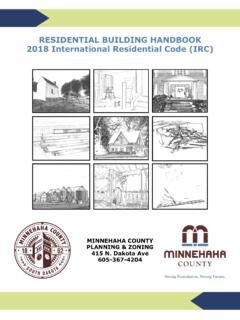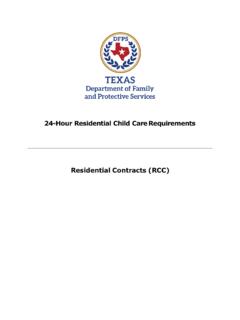Transcription of YOUTH RESIDENTIAL SERVICE PROVIDERS
1 ASSESSING THE USE OF LAW ENFORCEMENT BY. YOUTH RESIDENTIAL SERVICE PROVIDERS . Disability Rights Maine 24 Stone St, Suite 204. Augusta, ME 04330. August 2017. Table of Contents Introduction .. 1. Data Collection .. 6. Data Analysis .. 7. Calls to Law Enforcement per RESIDENTIAL 11. Reporting Rates of Law Enforcement Calls to DHHS .. 14. Recommendations .. 16. 19. Introduction Disability Rights Maine ( DRM ) produced this report as part of an effort to understand why Maine's YOUTH with disabilities are disproportionately arrested, criminally charged, and incarcerated. This effort began when the Maine Department of Corrections ( DOC ) issued a report indicating that as of July 2016, approximately one third of the YOUTH committed to Long Creek YOUTH Development Center ( Long Creek ) had come directly from RESIDENTIAL mental health treatment The cost of incarcerating our YOUTH is astronomical.
2 The cost of incarcerating our YOUTH due to mental illness is inexcusable. 2. As DRM explored this issue, it became clear that law enforcement calls from these RESIDENTIAL treatment programs often resulted from behaviors that were likely manifestations of the disabilities for which the YOUTH were being treated. This report is based on data DRM received from law enforcement agencies and Department of Health and Human services (DHHS) reports. It provides an analysis of that data and suggests some opportunities for reform. As the Protection and Advocacy (P&A) agency for people with disabilities in Maine, DRM believes that all YOUTH with disabilities have the right to appropriate and effective treatment in the least restrictive setting which is rarely, if ever, a correctional setting. DRM is hopeful that this report will help advance the conversation about how to keep YOUTH with behavioral health needs in the community, and out of the juvenile justice system.
3 To understand the problem, it is helpful to have some information on the continuum of care for YOUTH with disabilities in Maine. Federal and state laws require that treatment be delivered to YOUTH and their families in the least 1. Profile of YOUTH Committed at Long Creek YOUTH Development Center as of July 1, 2016 Report. Available at 2016/?ref=relatedSidebar 2. An Improved Police Response to Juveniles in Crisis: Overview and Discussion: Five Year Trend Analysis (2010- 2015), page 6, Sgt. Jonathan Shapiro , April 2015. 1. restrictive Intensive Temporary RESIDENTIAL Treatment programs ( RESIDENTIAL programs ) provide twenty-four (24) hour per day, seven (7) day per week structure and supportive living environment and active behavioral treatment, as developed in a treatment plan. 4 In order to justify treating a YOUTH in this out-of-home setting, Maine regulations explicitly require that there be a significant potential that the child will be hospitalized, or there is a clear indication that the child's condition would significantly deteriorate and would require a higher model of SERVICE than can be provided in the home and community.
4 5 A YOUTH must also meet additional criteria, including an Axis I or II. diagnosis from the most current version of the Diagnostic and Statistical Manual ( DSM ) that has lasted for at least six (6) months or is expected to last one year in the future; and must exhibit a need for therapeutic treatment or availability of a therapeutic on-site staff response on a 24 hour basis. 6 Moreover, eligibility criteria for this SERVICE include [s]ignificant recent aggression across multiple environments or severe enough within one environment to have caused serious injury or there is significant potential of serious injury to self or others; or recent homicidal ideation with risk of harm to others, or recent suicidal ideation with risk of harm to self, among other These services are mostly funded through Medicaid ( MaineCare ) and DHHS. currently contracts with eight private PROVIDERS statewide to deliver the DHHS reports that there is capacity to provide RESIDENTIAL services to over 300.
5 However, many PROVIDERS state that they are not filling all the beds in their programs, due to staffing challenges and the particular needs of the YOUTH currently within their programs. That said, even though these facilities are not generally operating at capacity, DRM assumed full capacity when generating the numbers contained within this report. 3. See: , 42 12101; 34-B Chapter 15, 15002(2)(A). See also: Olmstead v. , 527 581. (1999). 4. MaineCare Benefits Manual, Chapter II, 5. MaineCare Benefits Manual, Chapter II, (2). 6. Id. 7. MaineCare Benefits Manual Chapter II, and 2. 8. These PROVIDERS are: Spurwink, Sweetser, KidsPeace, NFI-North, Becket Family services , Aroostook Mental Health Care (AMHC), Opportunity Alliance, and The Northern Lighthouse Inc. 9. Child Mental Health PNMI Bed Occupancy Daily Report, KEPRO, available at 2. YOUTH enter RESIDENTIAL programs from many different settings.
6 Some of them are found eligible for this level of care and remain in their family home until a placement is available. Some await placement in much higher levels of care, like the local emergency department, hospital, crisis stabilization unit ( CSU ), or correctional facility. Unfortunately, the behavioral health system in Maine is overburdened at every level. YOUTH wait for months (or in some cases years) for the least restrictive level of care--outpatient or in-home and community services . Because of a lack of necessary and appropriate home and community based services , sometimes these YOUTH will find themselves in crisis, and require a higher level of care, which would not have been necessary with the proper in-home supports. This taxes the system - including RESIDENTIAL programs, the CSUs, and the psychiatric hospitals - each of which has YOUTH in their programs that do not need that level of care, but remain for want of a safe discharge option.
7 In other words, these YOUTH stay for months or years in restrictive settings because they cannot access a more appropriate level of treatment, despite being qualified and eligible. Throughout the continuum of care, crisis services are intended to be a safety net and point of contact for YOUTH experiencing a behavioral health crisis. There is a statewide hotline which anyone can call for emergency behavioral health services . These crisis [s]ervices are oriented toward the amelioration and stabilization of these acute emotional disturbances to ensure the safety of a member or society and can be provided in an office or on scene. On scene' can mean a variety of locations including member homes, school, street, emergency shelter, and emergency rooms. 10 Parents, educators, and RESIDENTIAL PROVIDERS all have this resource available to them when a YOUTH is in crisis. Unfortunately, all too often, concerned parties call law enforcement instead of crisis when there is a behavioral health This is problematic for several reasons: 1) crisis staff have the training and expertise necessary to respond appropriately;12 2) law enforcement resources are 10.
8 MaineCare Benefits Manual, Chapter II, 11. The reasons behind this deserve further exploration. Anecdotally, parents report that when they call the crisis hotline, they are often told that they may have to wait hours for a crisis worker to come to the home, and they are advised to go the emergency department and/or call law enforcement. 12. Staff providing Crisis services must have an MHRT (Mental Health Rehabilitation Technician) Certification at the level appropriate for the services being delivered. Supervisors of MHRT staff must be clinicians as defined in 11, within the scope of their licensure. MaineCare Benefits Manual, Chapter II, 3. diverted unnecessarily; and 3) YOUTH may incur criminal charges stemming from a behavioral health emergency. Sometimes, as a result of these criminal charges, YOUTH are brought to Long Creek YOUTH Development Center ( Long Creek ). This is Maine's only juvenile correctional It typically holds under 100 juvenile inmates, both male and female, and contains six functioning units (one unit for detained boys; one medium-risk boys' unit; one high-risk boys' unit; one unit for both detained and committed girls; one unit for low-risk transitioning boys; and the Special Management Unit).
9 According to a report produced by the Department of Corrections ( DOC ) in January 2017, as of July 2016, of YOUTH had come directly from RESIDENTIAL treatment, and had three or more mental health diagnoses when they came to Long Creek. 14. DRM has worked directly with many of these YOUTH , and conducts monthly monitoring visits to Long Creek. Unfortunately, Long Creek has become the default placement of last resort for YOUTH who fall through the cracks of the behavioral health system the unofficial, yet over-utilized, most restrictive level of care. Although Long Creek provides some access to mental health care, it is not the purpose of the facility, nor is it an appropriate treatment setting. [Long Creek] is not medically equipped to deal with the delicate needs of these vulnerable YOUTH . 15. Because Long Creek is not equipped to deal with YOUTH with significant behavioral health needs, and because almost 30% of the population there came directly from 13.
10 In July 2015, Mountain View YOUTH Development Center in Charleston, Maine stopped serving committed YOUTH and transferred its committed population to Long Creek. But YOUTH are still sometimes detained at Mountain View while awaiting adjudication. 14. Profile of YOUTH Committed at Long Creek YOUTH Development Center as of July 1, 2016 Report. Available at: 2016/?ref=relatedSidebar 15. Long Creek Board of Visitors Annual Report FY'16, page 2. Available at: 4. a RESIDENTIAL program, it is important to ask why YOUTH are moving from the behavioral health system to the correctional system in such high numbers. DRM sought to better understand this issue by researching the calls made to law enforcement agencies from RESIDENTIAL programs. After analyzing data from 21. law enforcement agencies as well as all the Reportable Events16 from DHHS for the same time period, DRM found that RESIDENTIAL staff frequently call law enforcement for behaviors that are manifestations of the youths' disabilities and the reasons the YOUTH are in treatment.




